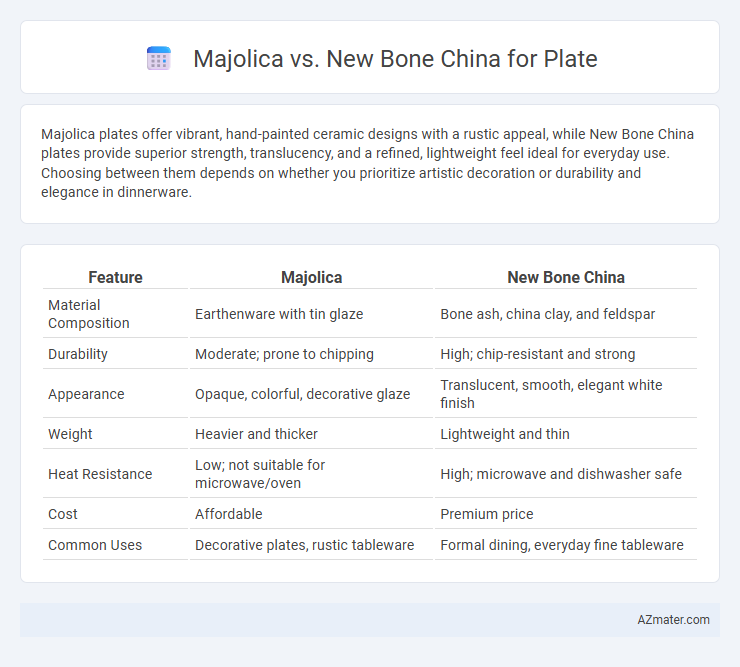Majolica plates offer vibrant, hand-painted ceramic designs with a rustic appeal, while New Bone China plates provide superior strength, translucency, and a refined, lightweight feel ideal for everyday use. Choosing between them depends on whether you prioritize artistic decoration or durability and elegance in dinnerware.
Table of Comparison
| Feature | Majolica | New Bone China |
|---|---|---|
| Material Composition | Earthenware with tin glaze | Bone ash, china clay, and feldspar |
| Durability | Moderate; prone to chipping | High; chip-resistant and strong |
| Appearance | Opaque, colorful, decorative glaze | Translucent, smooth, elegant white finish |
| Weight | Heavier and thicker | Lightweight and thin |
| Heat Resistance | Low; not suitable for microwave/oven | High; microwave and dishwasher safe |
| Cost | Affordable | Premium price |
| Common Uses | Decorative plates, rustic tableware | Formal dining, everyday fine tableware |
Introduction to Majolica and New Bone China
Majolica is a type of earthenware pottery known for its vibrant, colorful glazes and intricate hand-painted designs, often used in decorative plates that emphasize artistic expression and rustic charm. New Bone China is a modern formulation of bone china featuring a high level of whiteness, translucency, and durability, making it ideal for elegant, lightweight dinnerware plates with refined aesthetics. Both materials offer unique qualities: Majolica excels in ornamental appeal, while New Bone China prioritizes sophistication and practical strength in tableware.
Historical Background of Majolica Plates
Majolica plates originated in the Renaissance period, specifically in 15th-century Italy, characterized by their tin-glazed earthenware technique that allowed for vibrant, colorful designs and intricate patterns. These plates gained widespread popularity across Europe during the 16th and 17th centuries, reflecting the artistic and cultural trends of the era. Unlike New Bone China, which emerged in the 18th century with a focus on durability and translucency, Majolica plates are prized for their historical craftsmanship and decorative appeal.
Evolution and Modern Use of New Bone China
New Bone China evolved from traditional bone china by incorporating modern manufacturing techniques that enhance durability and translucency while maintaining a lightweight feel. Unlike Majolica, which is characterized by its colorful, lead-glazed earthenware and ornamental designs rooted in 19th-century European pottery, New Bone China offers refined elegance suited for contemporary tableware needs. Today, New Bone China plates dominate upscale dining environments due to their resistance to chipping and timeless aesthetic, reflecting advancements in ceramic technology and sustained consumer preference for high-quality porcelain.
Material Composition: Majolica vs New Bone China
Majolica plates are composed of earthenware clay coated with a tin glaze, offering a porous but brightly decorated surface ideal for vibrant colors and rustic textures. New bone china, by contrast, contains a high percentage of bone ash mixed with kaolin and feldspar, resulting in a translucent, highly durable, and lightweight ceramic that resists chipping. The inorganic composition of New bone china provides superior strength and whiteness compared to the more porous and less resilient majolica material.
Craftsmanship and Production Techniques
Majolica plates feature vibrant, hand-painted designs created through a tin-glaze technique that involves multiple firings, resulting in a glossy, textured surface prized for its artisanal quality. New Bone China plates are crafted using advanced porcelain blending, combining refined bone ash and kaolin, which allows for thinner, more durable pieces with a smooth, translucent finish. The craftsmanship of Majolica emphasizes traditional, decorative artistry, while New Bone China showcases precision manufacturing with enhanced strength and a delicate appearance.
Design and Aesthetic Differences
Majolica plates showcase vibrant, hand-painted designs with rich, earthy glazes that emphasize rustic charm and artisanal craftsmanship. New Bone China plates feature a refined, translucent white body with delicate patterns and gold or platinum trims, highlighting elegance and modern sophistication. The bold, textured surface of Majolica contrasts with the smooth, polished finish of New Bone China, catering to distinct aesthetic preferences in tableware design.
Durability and Everyday Usability
Majolica plates feature a dense, glazed earthenware composition that offers moderate durability but are prone to chipping under heavy use. New Bone China plates, crafted from refined porcelain with bone ash, provide superior durability combined with lightweight resilience, making them highly suitable for everyday use. The non-porous surface of New Bone China resists staining and thermal shock better, ensuring longevity in daily dining environments.
Price Point and Value Comparison
Majolica plates generally offer a more affordable price point compared to New Bone China, making them an attractive option for budget-conscious buyers seeking vibrant, hand-painted designs. New Bone China, while higher in cost, provides superior durability, translucency, and a refined finish that justifies its premium value for collectors and formal dining settings. The value of Majolica lies in its artistic appeal and rustic charm, whereas New Bone China excels in longevity and elegance, making the choice dependent on whether aesthetic uniqueness or long-term investment is prioritized.
Environmental Impact and Sustainability
Majolica plates, made from earthenware clay fired at lower temperatures, generally consume less energy during production than New Bone China, which requires higher firing temperatures and intensive mineral extraction. New Bone China incorporates bone ash, raising ethical concerns about animal-derived materials and increasing its environmental footprint due to resource-intensive processing. Majolica's biodegradability and potential for using locally sourced clay further enhance its sustainability profile compared to the more carbon-intensive manufacturing process of New Bone China.
Choosing the Right Plate: Majolica or New Bone China?
Majolica plates, known for their vibrant colors and hand-painted designs, offer durability and rustic charm, making them ideal for casual dining and decorative purposes. New Bone China plates provide superior strength, translucency, and a refined appearance, perfect for formal settings and everyday elegance. Choosing between Majolica and New Bone China depends on the desired aesthetic, usage frequency, and maintenance preferences, as New Bone China is more chip-resistant while Majolica requires gentle handling.

Infographic: Majolica vs New Bone China for Plate
 azmater.com
azmater.com